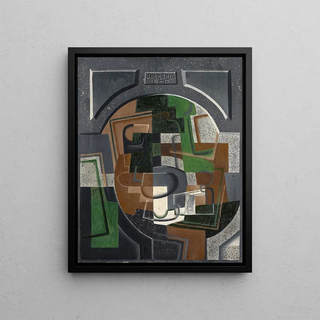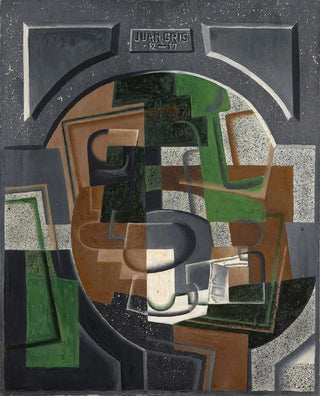Art print | Still life with blackboard - Juan Gris


View from behind

Frame (optional)
The artwork "Still Life with Blackboard" by Juan Gris is part of the Cubist movement, a pivotal period in art history that redefined aesthetic conventions. This piece, created in 1915, evokes a universe where geometric shapes and colors intertwine to offer a new vision of reality. The artist manages to capture the complexity of everyday objects, transforming them into a harmonious composition that stimulates the imagination. Through this work, Gris does not merely reproduce the visible world; he reveals its hidden layers, encouraging the viewer to look beyond appearances.
Style and uniqueness of the work
"Still Life with Blackboard" stands out for its bold use of shapes and volumes. Juan Gris, with his analytical approach, deconstructs the objects on the canvas, reassembling them into a visual symphony where each element finds its place in perfect balance. The dark tones and play of light create an atmosphere that is both intimate and mysterious. The presence of the blackboard in the background suggests a space for reflection and creativity, while the objects arranged on the table, such as fruits and instruments, symbolize the richness of daily life. Gris succeeds in transcending simple representation to offer a true sensory experience, where the viewer's gaze is guided through the different layers of the composition.
The artist and his influence
Juan Gris, born in Spain in 1887, played a leading role in the evolution of Cubism, alongside iconic figures like Pablo Picasso and Georges Braque. His artistic journey, marked by a constant quest for clarity and structure, made him a pioneer in the use of color and form. Gris was able to combine the influence of his homeland with the new Parisian trends, creating a unique style that continues to inspire generations of artists. By integrating collage elements and exploring multiple perspectives, he paved the way for future experiments in modern art. His work "Still Life with Blackboard" bears witness to this relentless pursuit of harmony between the figurative and the abstract.

Matte finish

View from behind

Frame (optional)
The artwork "Still Life with Blackboard" by Juan Gris is part of the Cubist movement, a pivotal period in art history that redefined aesthetic conventions. This piece, created in 1915, evokes a universe where geometric shapes and colors intertwine to offer a new vision of reality. The artist manages to capture the complexity of everyday objects, transforming them into a harmonious composition that stimulates the imagination. Through this work, Gris does not merely reproduce the visible world; he reveals its hidden layers, encouraging the viewer to look beyond appearances.
Style and uniqueness of the work
"Still Life with Blackboard" stands out for its bold use of shapes and volumes. Juan Gris, with his analytical approach, deconstructs the objects on the canvas, reassembling them into a visual symphony where each element finds its place in perfect balance. The dark tones and play of light create an atmosphere that is both intimate and mysterious. The presence of the blackboard in the background suggests a space for reflection and creativity, while the objects arranged on the table, such as fruits and instruments, symbolize the richness of daily life. Gris succeeds in transcending simple representation to offer a true sensory experience, where the viewer's gaze is guided through the different layers of the composition.
The artist and his influence
Juan Gris, born in Spain in 1887, played a leading role in the evolution of Cubism, alongside iconic figures like Pablo Picasso and Georges Braque. His artistic journey, marked by a constant quest for clarity and structure, made him a pioneer in the use of color and form. Gris was able to combine the influence of his homeland with the new Parisian trends, creating a unique style that continues to inspire generations of artists. By integrating collage elements and exploring multiple perspectives, he paved the way for future experiments in modern art. His work "Still Life with Blackboard" bears witness to this relentless pursuit of harmony between the figurative and the abstract.






